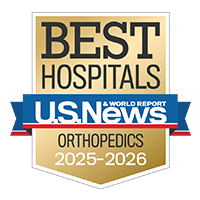Femoroacetabular Impingement (FAI)

Overview
Femoroacetabular impingement (FAI) is a condition in which the hip joint bones rub against one another during physical activity. The hip is a ball-and-socket joint, with the femoral head (the thighbone’s ball-like top end) located within the acetabulum (hip bone socket). In patients with FAI, either the femur or acetabulum is shaped abnormally – or both are – so they don't fit together as they should. People can be born with the abnormality (there may be a genetic component) or they can develop bone spurs (small bone growths) that result in the condition, which causes pain and may damage the joint.
Over time, FAI can cause tearing of the labrum (the hip socket's protective cartilage) and break down other cartilage lining the joint, which can lead to osteoarthritis.
Most often, people with FAI first notice symptoms in early adulthood, though some people aren't diagnosed until later in life.
Please visit the UCSF Hip Preservation Center website for more information.
Our approach to femoroacetabular impingement
UCSF is committed to helping patients with FAI return to the highest level of activity possible, whether they're enthusiastic weekend warriors or elite professional athletes. Our team includes orthopedic surgeons, primary care sports medicine doctors, physical therapists and athletic trainers, all of whom work together to develop individualized treatment plans for each patient.
Treatment for FAI typically begins with rest, anti-inflammatory medications and physical therapy. We offer the full range of physical therapies, including exercise regimens, functional fitness training and neuromuscular reeducation (techniques that condition the area to move normally again), in addition to providing information on the condition and instruction on proper technique.
When this approach doesn't relieve pain, patients may decide to have surgery. Experts in hip arthroscopy, our orthopedic surgeons make very small incisions and use specialized instruments to remove the bone spurs or address the abnormal bone shapes causing impingement and repair any associated damage. This minimally invasive approach has many benefits to patients compared with traditional surgery.
Awards & recognition
-

Among the top hospitals in the nation
-

Best in Northern California and No. 6 in the nation for orthopedic care
Signs & symptoms
People with FAI often have a long history of pain in the groin or front of the hip, which may become sharp with certain motions, especially hip flexion (moving the thigh toward the chest) and hip rotation. Some people have pain after sitting for long periods or when participating in sports and other physical activities.
Diagnosis
Doctors diagnose FAI by asking about symptoms and checking for hip pain during certain movements. X-rays often show bone spurs or an abnormally shaped hip joint, and an MRI may be needed to check for associated injuries, such as labral tears or cartilage damage.
Treatments
The initial plan for FAI usually includes rest, use of nonsteroidal anti-inflammatory drugs (NSAIDs) and physical therapy. A well-designed physical therapy program can benefit patients by improving the hip's range of motion, strengthening core muscles and offloading some of the weight usually borne by the hip joint. While oral NSAIDs, such as ibuprofen, can reduce the inflammation and pain associated with FAI, some patients get relief from corticosteroid injections.
In patients whose pain persists despite conservative treatment, arthroscopic surgery may be considered. Hip arthroscopy for FAI is an outpatient procedure that utilizes small incisions and specialized instruments to shave down the bone spurs or abnormally shaped parts of the bones. Labral tears may be repaired arthroscopically at the same time. Patients who undergo this minimally invasive surgery are usually on crutches for two weeks and can make a gradual return to sports over the following months. A key part of recovery, physical therapy focuses on regaining range of motion and rebuilding strength, and begins one week after surgery.
Frequently asked questions
- When can I shower after surgery?
You'll need to keep the incisions clean and dry until your first post-op visit, about a week after surgery. At that time, you'll likely be cleared to shower, but don't submerge the surgical site in a bathtub or swimming pool until three to four weeks have passed since your surgery.
- When should I have a follow-up appointment?
Plan to visit your doctor a week after surgery for an exam and X-rays.
- When should I start physical therapy?
You should start approximately one week after surgery. Patients commonly start right after the first post-op appointment.
- How long will I be on crutches?
Most patients use crutches for two weeks after hip arthroscopy.
- When can I drive after hip arthroscopy surgery?
Patients can drive once they no longer need crutches, typically two weeks after surgery.
- When can I return to school or work?
Most patients are ready to return to school or desk work five to seven days after surgery. If you’re able to work from home, your initial recovery period will be easier. If you have a physically demanding job that requires prolonged standing, walking or lifting, you may need more than a month for a safe recovery and medical clearance before returning to work.
- When can I return to recreational activities?
Generally, people resume playing sports and participating in other physical activities about six months after hip arthroscopy surgery.
UCSF Health medical specialists have reviewed this information. It is for educational purposes only and is not intended to replace the advice of your doctor or other health care provider. We encourage you to discuss any questions or concerns you may have with your provider.









